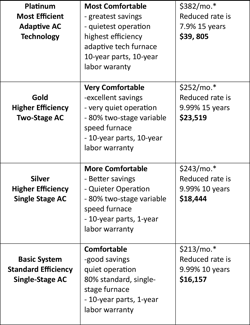BUSINESS MANAGEMENT / BY TOM PISCITELLI
Are Your Proposals Holding You Back?
Let’s take a deeper look into how your proposals can help you differentiate yourself from your competitors and increase the value of what you are offering.
Can you remember handwriting your proposals? If you do, you will also recall how long that took and your frustration when you made mistakes.
Today, many dedicated proposal software products and some CRM software products can create and save templated "packages" with proposal choices.
With all that technological progress, we have yet to make similar improvements in how and what is proposed. Let’s take a deeper look into how your proposals can help you differentiate yourself from your competitors and increase the value of what you are offering.
Bid, Estimate, and Quote
For decades, I've waged war against these three words. I hear full-time HVAC sales professionals use those terms constantly, partly because everyone else uses them to describe what they offer their customers. These terms are used without considering how they impact the customers’ perceptions of what they are buying.
AFUE, SEER, and BTUs
What training do new comfort advisors receive when they are first hired? Typically, the initial focus is developing expertise with products and their applications. They learn to size the equipment with a load calculation, how to describe the furnace, air conditioner, or heat pump, how it operates, the maximum distance to a neighbor's fence line, and a lot more. That information is essential but will be a distraction from the benefits the customer will receive.
Do You Have a Sales Process?
If you don’t have a complete sales process, your proposal won’t help you create the best results, no matter what you propose. I hope it includes the following:
- Email confirmation of the appointment
- Show up on time
- Meet and Greet
- Discovery of the customers’ problems
- Create (3-4) solutions to the customers’ problems
- Present a summary of the customers’ problems
- Present your Company
- Ask for the Sale
- Follow up until they “buy or die.”
- Create clients for life through consistent marketing.
If your selling process skips any of these steps, it will reduce your effectiveness, results… and income.
What You Propose is What Your Customers Will Buy
If you propose an 18 SEER air conditioner or a 96% gas furnace, that is what you are asking your customer to “buy.” If they challenge you on the price, it's your fault because what you showed them was the product and the price. You have set yourself up for an apples-to-apples comparison with your competitors, and those fights are tough to win.
So, think about it. When you are “selling” the product, the customer believes they are getting “what it is.” When you are “selling” what the product does for the customer, you are selling the benefits and the value that apply to them.
Creating the Proposal
1. Find the customers’ problems by asking questions, looking for clues, and taking measurements.
2. Summarize the problems in writing—a short list.
3. Create Solution Choices that will solve the customers' problems.
- Begin with the Best Solution, without regard to price, then make a bottom choice, the minimum solution, and finally, two in between.
- Each Solution will address your customers’ problems but with varying effectiveness. Think of this as a “take-away” approach from the Best down to the Basic Choice.
Next Time: Present – Propose – Close
P.S. Here is an example of a customer-friendly proposal that can be presented comfortably and confidently, ccourtesy of Silver Bullet: www.silverbullet.ac.
Well-known and highly-regarded throughout the HVAC training world, Tom Piscitelli's background includes 20 years in sales management with Honeywell, focusing on residential-light commercial HVAC and plumbing contractor business development., and four years in HVAC distribution sales management. He has conducted HVAC contractor in-home sales training, technician sales training and business consulting. He has trained over 14,000 contractor sales professionals in his TRUST® Sales Process.
Find Tom at his website, TRUST Sales Training and Coaching
Tom Piscitelli Backgrounder
· Twenty years of sales and sales management with Honeywell, focusing on residential-light commercial HVAC and plumbing contractor business development.
· Four years of HVAC distribution sales management.
· 20 years dual emphasis:
o HVAC contractor in-home sales training, technician sales training, and business consulting.
o HVAC B2B sales training and coaching.
o She has published articles in Contracting Business, HVAC Business Magazine, etc.
- SecureAire Vice-President of Distribution www.secureaire.com
The TRUST® Sales Process and Philosophy www.sellingtrust.com
· Created the TRUST® Sales Process and have trained over 14,000 contractor sales professionals.
o T = Tell the Truth
o R = Relationship
o U = Understand the Customer
o S = Show Choices
o T = Take Action
· The TRUST® philosophy and principles are best described as a "soft sell with high skill" approach to selling.
· Also, we are quickly embracing AI's potential to enhance communication effectiveness, which will indeed migrate into HVAC proposals.
About the Author
Tom Piscitelli
Vice president, distributed markets
Tom Piscitelli, a 45-year veteran of the HVAC industry, is vice-president of distributed markets at SecureAire.
He is seeking dealers who are interested in learning more about SecureAire’s winning and profitable Particle Control Technology.
Contact Tom at [email protected] or 425-985-4534.


